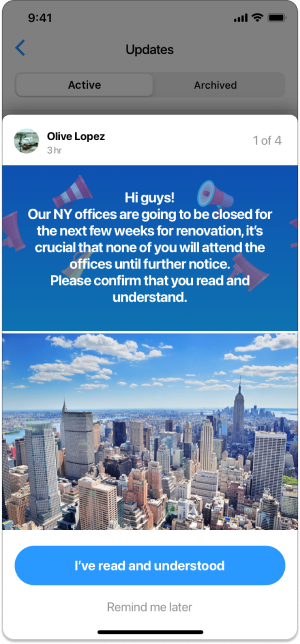When disaster strikes, learn five strategies for providing affected employees with the short- and long-term care they need to get back on their feet.
Expert Take: Supporting Your Employees After Natural Disasters
Key takeaways
- Strategies to support employees following natural disasters include frequent communication with employees and stakeholders, immediate relief assistance, company benefits reminders, and developing a plan for future emergencies.
- What employees need day-to-day and month-to-month following natural disasters changes; be open to changing how you support employees as time passes, including extending access to leave and mental health resources.
- To support the people and communities impacted by these disasters, you can donate to national charities like the American Red Cross or local charities like BeLoved Asheville.
5 Expert Tips for Supporting Employees After Natural Disasters
Employees from Florida to North Carolina experienced the devastation wrought by Hurricanes Helene and Milton. With many employees displaced and others without clean drinking water, electricity, or shelter, there are plenty of big and small things you can do to support your staff and the community impacted by these storms.
1. Communicate Frequently Through Multiple Channels
Communication is vital before, during, and after natural disasters, and you must position your company as a reliable source of updates, comfort, and support. In the wake of a disaster, you won’t know the exact extent of damage or loss for each employee; some could be without power, some without internet, and some may only have access to mobile devices.
Post announcements through all company channels, including emails, newsletters, HRIS, productivity applications, social media accounts, intranet, texts, and even on-site posters. Using multiple channels gives you more ways to check on the safety of your employees and their families following the disaster. If you don’t hear personally from an employee after the disaster, try calling them or their emergency contacts as soon as possible.
All of your messages should be brief and empathetic, while giving employees access to need-to-know information, like business operations and disaster updates. Remember that the goal of your communications is to share information, not just ask when employees can return to work. If you have a work communication platform like Connecteam, you can send emergency messages and monitor read receipts so staff don’t miss critical communications. Learn more about the platform in our Connecteam review.

Connecteam’s mobile app displays a pop-up window with a message notifying employees of closures to NY-based offices above a read confirmation button.
Avoid Spreading Misinformation
Unfortunately, it is not uncommon for bad actors to take advantage of the chaos after natural disasters by spreading rumors, promoting scams, or gouging prices for essential items.
To combat this, make sure your communications direct employees to trusted sources, such as government websites, and double-check any news you learn about through social media. For more, check out the Federal Emergency Management Agency’s Hurricane Rumor Response.
2. Provide Immediate Relief Assistance
Once you’ve confirmed the safety of your employees following a natural disaster, be prepared to offer relief assistance to them, such as:
- Offer temporary shelter: Employees may have lost their homes or access to water or electricity. Consider sponsoring rooms in extended-stay hotels, directing employees to nearby shelters, or partnering with schools, hospitals, or religious centers that may be willing to provide space for affected employees.
- Provide transportation: After a natural disaster, employees may not have reliable transportation or access to fuel. You can help by setting up shuttle services, organizing carpool services, or even offering gift cards and stipends for public transportation and rideshare services so that employees can get to work and other important destinations.
- Organize a grocery and clothing drive: Create a base to collect and distribute essential items for affected employees. This could take various forms, such as donating food and water; offering employees access to on-site kitchens or break rooms; or providing clothing, toiletries, and sanitary items.
- Start a disaster relief fund: Open a fundraiser where you and your staff can donate funds to support the needs of various employees, including shelter, transportation, food, water, clothing, medical assistance, or home repairs.
- Coordinate volunteer projects: Create a place, such as an internal company channel, for employees to ask for help on various projects. For example, you can use this channel to manage requests for home improvement aid, babysitters, or pet care after a disaster.
Heads-up!
As a small business, providing employees with all the assistance options above is unrealistic since your company may also be in dire straits following a natural disaster. If this is you, there are other ways to help.
“Look into community resources and government aid programs that can help both your business and your employees,” suggests Amy Spurling, CEO and Founder of Compt, an employee stipend program. Partnering with community groups instead can be a great way to direct your staff to the aid they need if you have limited time, money, and resources.
3. Remind Employees About Company Benefits and Leave Practices
Remind employees of the physical, emotional, and financial wellness programs you offer outside of the immediate aid options listed above. You’ll also want to be empathetic and flexible when administering benefits and accommodations. For example, you may want to offer more flexible paid leave policies for affected employees as they deal with the stress and trauma of the natural disaster.
Check out my list of benefits resources below for more information on pivotal employee benefits following a natural disaster. You may also want to consider offering your employees temporary benefits, like on-site counselors, commute stipends, remote work options, or access to emergency funds and loans, so employees have a more holistic range of options to find their needs.
- Major Types of Employee Benefits to Offer
- How to Create a PTO Policy: Small Business Guide
- What Is a Flexible Work Schedule Policy?
- What Are Employee Wellness Programs? A Small Business Guide
- What Is an EAP? Small Business Guide
- Managing Remote Employees: Tips for Success
- Employee Financial Wellness: Programs and Benefits
- How to Improve Mental Health in the Workplace
The Legal Perspective
You must keep track of any exceptions or deviations you make from your benefits policies, as these could set future precedents. For example, if you have an accrual PTO policy and allow an employee to use paid time off before accruing it, you must offer this flexibility to employees in the same situation. This is to avoid claims of unfair or discriminatory practices.
There are also tax consequences to the benefits and relief assistance you provide employees. Fringe benefits are typically subject to employment taxes, but certain exceptions occur during disasters. I recommend consulting with your accountant, an employment law attorney, or the IRS’s 15-B Employer’s Tax Guide to Fringe Benefits. If you partner with a professional employer organization, they can also be a great resource.
However, providing comprehensive benefits to employees after a disaster can be a defining moment for your company’s brand and culture. “While it’s important to understand your legal obligations, I always advise going beyond the bare minimum,” explains Spurling. “If you’re unsure about legal requirements, consult with an employment lawyer, but always err on the side of supporting your people.”
4. Update Stakeholders on Business Operations
Your stakeholders are your customers, investors, and staff. From a practical standpoint, you’ll want to notify your investors and customers about projected business closures or service delays. Be honest about changes in your service levels, especially if you need to temporarily close or have limited staff and resources.
You’ll also want to clarify employees’ work expectations if some team members cannot work after the disaster. Use some of the questions below to start:
- What are the temporary hours of operation?
- When will you notify team members of shifts or schedules?
- How often should employees inform managers of their availability?
- Will non-exempt employees be eligible for overtime, double time, or other types of incentive pay?
- Do employees have the option to work remotely?
You may ask the employees not affected by the disaster to work extra hours to ensure critical operations continue. For example, when I worked in HR outsourcing, my team worked late processing customer payrolls manually following city-wide blackouts, even driving paychecks to our customer’s businesses. In return, we received overtime, bonuses, free dinner, and recognition from our company executives and customers for our efforts.
You’ll want to provide similar incentives and recognition to employees who step up during this time. You may even pinpoint emerging leaders who go out of their way to help customers or train employees in new processes to fill productivity gaps.
Should you close during and after a natural disaster?
Use your best judgment, but always prioritize employees’ and your safety above everything else. If keeping your business open risks employees’ health and well-being, it is better to close down unless you are an essential service and legally can not.
Structural damage, loss of utility services, or impassable road conditions can also make opening unreasonable and further endanger your staff. You should address those issues first before reopening and returning to normal business operations.
5. Prepare Processes for Future Emergencies
Use the resources you prepared for your staff during this time as a basis for future emergency action plans (EAPs) or natural disaster policies. Developing these policies can streamline business processes and communication during disasters to reduce confusion and increase the likelihood of employee and business safety and security.
Traditional EAPs typically outline evacuation and reporting procedures plus instructions for employees who need to perform essential functions and medical duties in the face of an emergency. However, your emergency policies should also include a detailed recovery plan, a list of important contacts, communication methods, disaster benefits offerings, phased return-to-work procedures, and business continuity expectations.
How Your Business Can Support Those Impacted by Natural Disasters
There are several charities accepting donations for Hurricanes Helene and Milton relief efforts. Below are a few options:
If you want to donate to specific organizations, make sure they are reputable first. Many scammers try to take advantage of our generosity and desire to help following natural disasters. To avoid this, I recommend using ProPublica’s NonProfit Explorer and Charity Navigator as starting places for investigating the legitimacy of nonprofit organizations; you’ll also get peace of mind knowing that your money is going to places making the most impact on affected communities.
Other Small Business Resources Following Natural Disasters
If your small business is also reeling from a natural disaster, you can check out some of our other FitSmallBusiness resources below:
- SBA Disaster Loans: Everything You Need to Know
- What SBA Economic Injury Disaster Loans Are & How They Work
Plan for Long-term Support
Supporting employees in the wake of disaster is an ongoing effort. Even with your employees’ basic needs like food, water, shelter, electricity, personal hygiene, and transportation met, expect the emotional toll following the loss of loved ones or property to continue.
Check in regularly with your affected staff and be prepared to offer extended support. Equip your managers with the tools to monitor direct reports for signs they need help. You should also provide more informal ways for employees to reach out for assistance or express concerns, like anonymous suggestion boxes or access to peer communities, like employee resource groups (ERGs) and DEI committees.
“As a leader, your response to employee crises shapes your company culture more than any mission statement ever could,” says Spurling. Long-term crisis support is key to developing a positive community reputation, fostering trust with your employees, and creating a more resilient small business.
Meet the Experts
Learn about the experts who contributed their knowledge to this article.
 | Jessica Dennis is a lead writer and content strategist for Fit Small Business. She also lends her HR knowledge to TechnologyAdvice and TechRepublic. With over 6 years of direct HR experience, she helped balance business obligations with the needs of employees during the height of the COVID-19 pandemic. Her expertise in small business HR administration informs her content, providing unique insights that help companies care for their most valuable resource: their people. |
 | Amy Spurling is the Founder and CEO of Compt, HR software that empowers companies to offer truly personalized lifestyle benefits that cater to each employee's unique needs. With over two decades of experience as a three-time CFO and two-time COO, Amy has driven more than $200M in financing and led two successful acquisitions in venture-backed startups. Her innovative HR platform is reshaping how businesses approach employee satisfaction and productivity, fostering an environment where company and individual growth are intrinsically linked. |